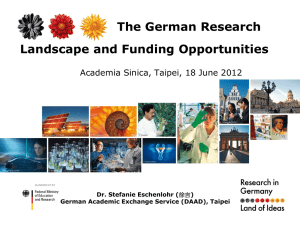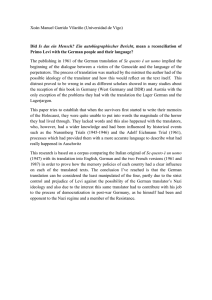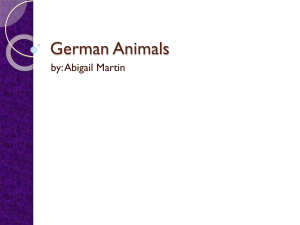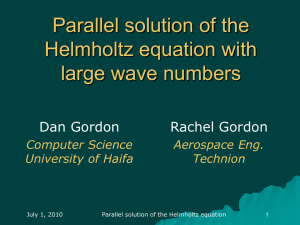The German Research Landscape and Current
advertisement
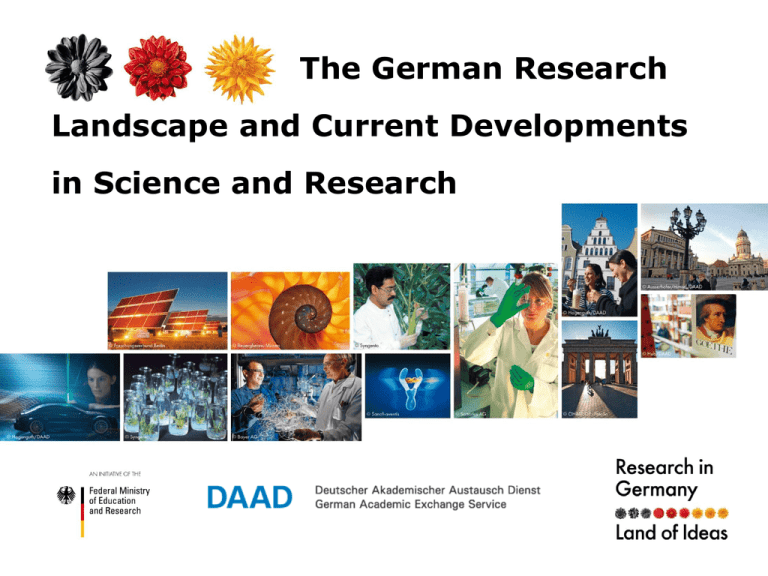
The German Research Landscape and Current Developments in Science and Research Content The German Research Landscape Current Developments in Science and Research The German Research Landscape Facts and Figures approx. 750 publicly funded research institutions, about 100 research networks and clusters 549,000 staff in Research and Development, approx. 320,000 scientists and researchers bilateral, European and multilateral cooperations with more than 40 countries („WTZ-Abkommen“/ Agreements on scientific and technical cooperation) Gross Domestic Expenditure on Research and Development: 69,9 billion euro (in 2010) Source: Federal Statistical Office (preliminary numbers for 2010) The German Research Landscape Different players Research at institutions of Higher Education Non-university research facilities Industrial research Higher Education Institutions Institutions of Higher Education 108 universities 210 universities of applied sciences 6 colleges of education 16 colleges of theology 52 colleges of art 29 colleges of public administration Features of German universities Unity of research and teaching Broad range of subjects Theoretical orientation of research Source: Federal Statistical Office (August, 2012) Higher Education Institutions Facts and Figures: 2.38 million students enrolled in German higher education institutions Approximately 264,000 international (11.1%) and 2.1 million German students enrolled at German universities Public expenditure for institutions of higher education: 41.229 billion euros (2010) Excellence Initiative by the German States (“Länder”) and the Federal Government: From 2006–2017 a total of 4.6 billion euros will be invested to promote top-level research More information is offered by the German Rectors’ Conference at www.hrk.de Excellent non-university research institutions Max Planck Society Helmholtz Association of National Research Centres www.mpg.de/en www.helmholtz.de/en/ Leibniz Association Fraunhofer Gesellschaft www.wgl.de www.fraunhofer.de/en Excellent non-university research institutions Max Planck Society www.mpg.de The Max Planck Society (MPG) is an independent, non-profit research organisation named after the world-famous physicist Max Planck (1858– 1947). With its focus on basic research in the natural sciences and humanities, the MPG complements research projects at universities. The MPG is wellknown for its excellence in research. Seventeen scientists at the MPG have received the Nobel Prize. Facts and Figures: 80 institutes and research centres Staff: 17,019 Budget: 1.5 billion € Max Planck Institute for Molecular Biomedicine in Münster Research budget (Source: MPG) Excellent non-university research institutions Helmholtz Association of National Research Centres www.helmholtz.de The Helmholtz Association of German Research Centres provides top scientific achievements to society, science and industry for addressing the major challenges of today. The Helmholtz Association is the largest scientific organisation in Germany. Its work follows the tradition of the great natural scientist Hermann von Helmholtz (1821–1894). Scientists in 18 Helmholtz Centres work on a wide variety of topics in areas ranging from health, the environment and energy to fundamental research such as elementary particlephysics. Facts and Figures Deutsches Elektronen-Synchrotron DESY A Research Centre of the Helmholtz Association 18 research centres Staff: 33,634 Budget: 3.4 billion € Research Budget (Source: Helmholtz) Excellent non-university research institutions Leibniz Association www.wgl.de The Leibniz Association is the umbrella organisation for 86 research institutions which address scientific issues of importance to society as a whole. The Leibniz Institutes conduct research and provide infrastructure for science and research and perform research-based services – liaison, consultation, transfer – for the public, policy-makers, academia and business. The Berlin Museum for Natural History (Museum für Naturkunde), one of the ten largest scientific collections in the world, is a prominent example of a Leibniz Association member. Facts and Figures: 86 institutes and research facilities Staff: 17,300 Budget: 1.5 billion € Research Institute and Museum for Natural History Berlin Research Budget (Source: Leibniz) Excellent non-university research institutions Fraunhofer Gesellschaft www.fraunhofer.de The Fraunhofer-Gesellschaft conducts applied research for both private and public enterprises, as well as for the general benefit of the public. The association takes its name from Joseph von Fraunhofer (1787– 1826), the illustrious Munich researcher, inventor and entrepreneur. The Fraunhofer-Gesellschaft is the largest organisation for applied research in Europe. It conducts research under contract for industry, the service sector and public administration and also offers information and services. Facts and Figures Fraunhofer Institute for Industrial Mathematics (ITWM) Kaiserslautern 80 research facilities Staff: 20,000 Budget: 1.8 billion € Research Budget (Source: Fraunhofer) Excellent non-university research institutions Federal research institutions/ Departmental research (41 institutes funded by the Federal Ministries, staff: 21,000 in 2010) “Länder” institutions (167 research organisations funded by Germany’s federal states/“Länder”, staff: 5,600 in 2010) Academies of Science (about 10 publicly funded organisations) Intensive Industrial Research Almost 70% of the research investments in Germany are spent by the industrial sector (approx. 47 billion euros) Numerous industrial research facilities and companies are closely cooperating with universities and other research institutions (networks and clusters) The German Federation of Industrial Research Associations (AiF) promotes research and development in all industry sectors Industries strong in research: Automobile industry, electrical engineering, chemical industry and mechanical engineering Basic and Applied Research Applied Research Industry FraunhoferGesellschaft Leibniz Association Helmholtz Association Basic Research Universities Max Planck Society Public Funding Private Funding Expenditure on Research and Development Research expenditure 2010 (in total): 69,9 billion euros Universities Max Planck Society Helmholtz Association 18,0 % Fraunhofer -Gesellschaft Leibniz Association other public or private research institutes Source: Federal Statistical Office (numbers for 2010) 67,2 % Industry Research Funding Primary Sponsors Secondary Sponsors Federal Government/ Ministries German Research Foundation “Länder”/States German Academic Exchange Service Industry Alexander von Humboldt Foundation Foundations etc. Find out more: http://www.research-in-germany.de Content 1. The German Research Landscape – Overview 2. Current Developments in Science and Research Current Developments in Science and Research Strategy for the Internationalisation of Science and Research High-Tech Strategy Excellence Initiative Joint Initiative for Research and Innovation Higher Education Pact Seventh Framework Programme, European Research Council Horizon 2020 – EU-Programme for Research and Innovation Strategy for the Internationalisation of Science and Research The strategy pursues four main goals: Strengthening cooperation between the best researchers Gaining access to international innovation potentials Sustainably strengthening cooperation with developing countries in the fields of education, research and developmen Assuming international responsibility to overcome global challenges Source: Federal Ministry of Education and Research (BMBF) The High-Tech Strategy Initiative launched by the federal government to encourage the development of lead markets, enhance cooperation between science and industry, and improve framework conditions for innovations Definition of 5 lead markets and priorities Climate and Energy Health and Nutrition Mobility Security Communications Source: Federal Ministry of Education and Research (BMBF) Excellence Initiative An initiative by the Federal Government and the Länder Aims of the Excellence Initiative: Promote top-level research Improve the quality of German universities and research institutions Increase Germany’s international competitiveness Two programme phases: 1.9 billion euros in the first programme phase between 2006 and 2012 2.7 billion euros in the second programme phase between 2012 and 2017 Source: German Research Foundation (DFG) Excellence Initiative Three funding lines: 1) Graduate Schools to promote young academics 2) Clusters of Excellence to promote top-level research 3) Institutional strategies to promote top-level university research First Phase 2006 - 2012: Second Phase 2012 - 2017: 39 graduate schools 45 graduate schools 37 clusters of excellence 43 clusters of excellence 9 institutional strategies 11 institutional strategies Source: German Research Foundation (DFG) Excellence Initiative 11 German universities with excellent future concepts (new projects italicized) Aachen University of Technology Free University of Berlin Humboldt University of Berlin University of Bremen Dresden University of Technology Ruprecht-Karl University of Heidelberg University of Cologne University of Constance Ludwig-Maximilians-University of Munich Technical University of Munich Eberhard-Karls University of Tübingen Source: German Research Foundation (DFG) Excellence Initiative Funding decisions in the second programme phase: 99 projects at 39 universities Source: German Research Foundation (DFG) Joint Initiative for Research and Innovation Financial planning security to research institutions Research policy goals: Trigger dynamic developments in the science system through an annual increase of funding by 5% from 2011-2015 Create dynamic and performance-enhancing networks in the science system Develop and implement new international cooperation strategies Establish sustainable partnerships between science and industry Recruit the best and persuading them to stay in Germany long-term Source: Federal Ministry of Education and Research (BMBF) Higher Education Pact Initiative of the Federal Government and the “Länder” to provide the universities with additional resources for admitting more students Background: First programme phase 2007-2010: a total of 91,370 additional new university entrants by 2010 (compared to the number in 2005); actual number of new entrants 185,024 Second programme phase 2010-2015: 275,000 additional university entrants Source: Federal Ministry of Education and Research (BMBF) Seventh Framework Programme – European Research Council (ERC) The 7th Framework Programme for Research has two main strategic objectives: to strengthen the scientific and technological base of European industry to encourage its international competitiveness, while promoting research that supports EU policies. Duration: 2007-2013 Total budget: over 50 billion euros Source: European Commission – Research and Innovation Seventh Framework Programme – European Research Council (ERC) Specific programmes: Cooperation (to foster collaborative research across Europe) Ideas (to support “frontier research”) People (to support researcher mobility) Capacities (strengthen research infrastructures) Nuclear Research Source: European Commission – Research and Innovation Horizon 2020 EU Framework Programme for Research and Innovation 2014 – 2020 Combines 3 individual projects/initiatives* Total budget: 80 billion euros Three priorities: Excellent research Industrial leadership Societal challenges *The 7th Research Framework Programme (FP7), innovation aspects of Competitiveness and Innovation Framework Programme (CIP), EU contribution to the European Institute of Innovation and Technology (EIT) Thank you for your attention! Contact: DAAD Tel.: E-mail: www.research-in-germany.de
